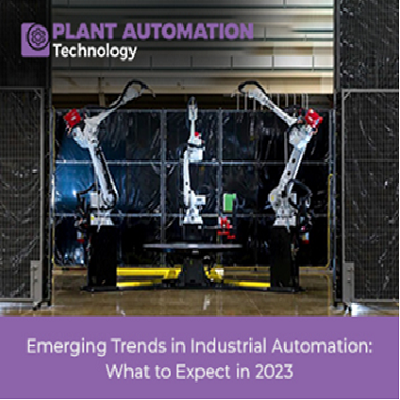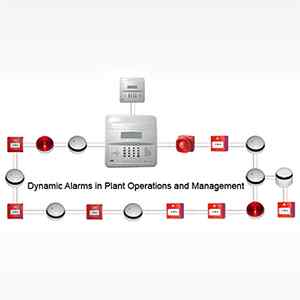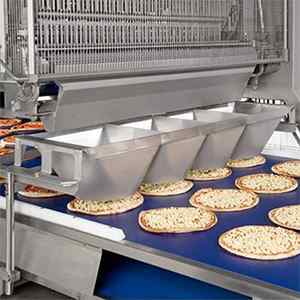Emerging Trends in Industrial Automation: What to Expect in 2023

Introduction:
The field of industrial automation is constantly evolving, driven by technological advancements and the need for increased efficiency and productivity. As we enter 2023, it's essential to explore emerging industrial automation trends.
Industrial automation trends in 2023 will reshape industries across the board. Automation and robotics look promising as companies embrace the latest advancements. Key players in the industry will closely follow industrial automation trends 2023 to stay ahead of the curve. The year 2023 is expected to witness a surge in automation technologies. Businesses are eager to leverage these technologies to gain a competitive edge. Automation predictions for 2023 indicate that there will be a strong focus on improving operational efficiency, reducing costs, and enhancing productivity.
One of the most exciting areas of development is the integration of industrial automation with the Internet of Things (IoT). Industrial automation trends 2023 suggest that IoT will play a vital role in enabling connectivity and data exchange among devices, machines, and systems. The seamless flow of information will empower companies to make data-driven decisions, optimize processes, and achieve higher automation levels.
Moreover, industrial automation developments in 2023 will witness smart factories. These factories will be equipped with automation technologies such as robotics, AI, and IoT, allowing for intelligent and autonomous production systems. Industrial automation innovations in 2023 will drive the transformation of traditional manufacturing setups into highly efficient, flexible, and interconnected ecosystems.
As businesses embark on their automation journey, they need to keep a keen eye on the latest industrial automation news. Staying updated with the latest advancements, successful case studies, and industry insights will provide valuable guidance for implementing automation strategies effectively.
From cutting-edge technologies to transformative practices, this article delves into predictions and expectations for the year ahead.
Industrial Automation Trends in 2023
In 2023, several trends are poised to transform the industrial automation sector. One significant trend is the increasing integration of artificial intelligence (AI) and machine learning (ML) into automation systems. AI algorithms enable machines to analyze vast amounts of data, facilitating real-time decision-making and predictive maintenance. This integration will enhance operational efficiency, reduce downtime, and optimize production processes.
Another noteworthy trend is the proliferation of collaborative robots or cobots. These robots work alongside human workers, augmenting their capabilities and improving safety on the shop floor. Cobots are expected to witness significant growth in 2023 as industries recognize their potential for productivity and flexibility.
Another significant trend in industrial automation 2023 is the increasing demand for automation solutions in sectors beyond traditional manufacturing. Industries such as healthcare, logistics, agriculture, and construction recognize the potential for automation to improve efficiency and streamline operations. Automation trends in 2023 indicate that these industries will witness the rapid adoption of technologies like robotics, AI, and autonomous vehicles. This will automate processes and enhance productivity.
Furthermore, automation predictions 2023 highlight the importance of cybersecurity in the industrial automation landscape. As automation systems become more interconnected and data-driven, robust cybersecurity measures become paramount. Companies will invest heavily in protecting sensitive data, intellectual property, and critical infrastructure from cyber threats.
Automation and robotics in 2023 are not limited to large-scale enterprises. Small and medium-sized businesses will also embrace automation innovations in 2023 to gain a competitive advantage. Automation technologies that are more accessible and affordable, such as cloud-based automation platforms and plug-and-play robotic systems, will enable smaller businesses to automate their processes and stay relevant in a rapidly changing market.
Emerging Technologies in Industrial Automation
Emerging technologies will impact industrial automation in 2023. One such technology is the Internet of Things (IoT). The widespread adoption of IoT devices and sensors allows for the collection and analysis of real-time data, enabling predictive maintenance, efficient inventory management, and remote monitoring of industrial processes.
Training and maintenance in industrial automation are being reshaped by augmented reality (AR) and virtual reality (VR). These immersive technologies empower technicians to troubleshoot and visualize intricate machinery virtually, resulting in improved training efficiency, reduced errors, and minimized downtime.
Predictions for Industrial Automation in 2023
Looking ahead to 2023, experts predict key industrial automation developments. One prediction is the rise of edge computing in automation systems. Edge computing brings data processing and analysis closer to the source, reducing latency and enabling faster decision-making. This advancement is crucial for real-time applications and enhances industrial automation systems' overall performance and reliability.
An additional forecast revolves around the growing adoption of robotics process automation (RPA) across diverse industries. RPA automates repetitive and rule-based tasks, allowing human workers to concentrate on more intricate and innovative undertakings. Implementing RPA is projected to streamline workflows, enhance accuracy, and generate cost savings.
The Future of Industrial Automation and Robotics
Industrial automation and robotics have immense potential. As technology advances, we anticipate an even broader integration of automation systems across industries. AI, IoT, and robotics convergence will lead to smart factories, where autonomous systems will revolutionize production, supply chain management, and quality control, optimizing operations to unprecedented levels.
Moreover, ethical considerations surrounding automation and job displacement will become increasingly significant. It is crucial for stakeholders to prioritize reskilling and upskilling programs to ensure a smooth transition for the workforce affected by automation. The collaborative nature of cobots will also contribute to the future of work, where humans and robots coexist and complement each other's strengths.
Conclusion
In summary, 2023 is poised to be a transformative year for industrial automation. The integration of AI, IoT, and robotics, along with AR, VR, and edge computing, will revolutionize manufacturing processes, improve efficiency, and enhance worker safety. Industry leaders must stay abreast of these emerging trends and embrace their opportunities. This will enable them to unlock industrial automation's full potential in the years to come.







